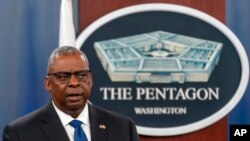South Korean concerns about the U.S. nuclear umbrella are expected to be a major focus of U.S. Defense Secretary Lloyd Austin’s upcoming trip to Seoul.
Austin, who arrives in the South Korean capital on Monday, is expected to meet President Yoon Suk Yeol, according to South Korean media.
Earlier this month, Yoon made headlines when he said South Korea could demand the redeployment of U.S. nuclear weapons, or even develop its own nuclear arms, if its security situation with North Korea worsens.
Yoon later walked back those comments. However, the situation underscores growing South Korean worries over North Korea’s quickly expanding nuclear arsenal, as well as questions about the long-term defense commitment of its ally, the United States.
Deputy Pentagon press secretary Sabrina Singh told a briefing Thursday that Austin's trip will highlight “our commitment to the region,” saying the U.S. commitment to South Korea remains “rock solid.”
Austin’s visit will be closely watched to see whether he addresses Yoon’s comments about nuclear weapons.
“He might make some rhetorical gesture indicating gently in public, and certainly much more strongly behind the scenes, that it would be undesirable for South Korea to have its own nuclear deterrent,” said Mason Richey, an associate professor at South Korea's Hankuk University of Foreign Studies.
“But I think he would do so in a way that would not be intended to publicly irritate South Korea or to call into question South Korea’s sovereignty or autonomy,” Richey said.
Instead, Austin may highlight U.S.-South Korean efforts to expand defense cooperation, he added.
In recent months, Washington and Seoul have increased joint military drills and agreed to the more frequent deployment of U.S. strategic assets, such as nuclear-capable bombers and aircraft carriers, to the region around the Korean Peninsula.
But Yoon, a conservative who embraces a more aggressive approach to North Korea, thinks more should be done to keep up with North Korean nuclear advancements.
As a presidential candidate, he briefly embraced the possibility of the United States returning tactical nuclear weapons to South Korea.
The United States removed its nuclear weapons from South Korea in the early 1990s. Instead, South Korea is protected by the U.S. nuclear umbrella, under which Washington vows to use all its capabilities, including nuclear weapons, to defend its ally.
Yoon last month suggested such ideas are outdated and that South Korea needs a bigger role in its own defense. As an alternative, Yoon said he envisioned new levels of nuclear cooperation that would have the same effect as nuclear sharing.
North Korea advancements
South Korea’s concerns are driven in large part by North Korea’s rapid expansion of its nuclear weapons program.
In 2022, North Korea launched more than 90 missiles, including short-range weapons designed to evade South Korea’s missile defense systems and long-range weapons that could hit the U.S. mainland.
In a year-end speech, North Korean leader Kim Jong Un vowed to “exponentially” increase production of nuclear warheads and to develop yet another new intercontinental ballistic missile.
U.S. and South Korean officials have also warned for months that North Korea has finished preparations for another nuclear test.
The developments have rattled many in Seoul, who fear the United States may not come to the defense of South Korea if North Korea has the ability to destroy U.S. cities.
Possible steps
A growing number of Washington-based analysts agree that the United States should shore up its defense commitment to South Korea.
In a report last week, the Center for Strategic and International Studies said the allies should consider “tabletop planning exercises for the possible redeployment of U.S. nuclear weapons to South Korea."
While the CSIS report said the United States should not under current circumstances deploy tactical nuclear weapons, it suggested other steps, including the creation of a “framework for joint nuclear planning,” similar to a U.S. arrangement with NATO.
The report mentioned the possibility of "the continuous presence in the region of either U.S. submarines equipped with nuclear cruise missiles or strategic bombers. It also said South Korea could acquire dual-capable aircraft, which can conduct nuclear or conventional missions.
It is not clear whether U.S. and South Korean officials are discussing any of those proposals.
But Sydney Seiler, the national intelligence officer for North Korea at the U.S. National Intelligence Council, on Thursday praised the CSIS report as “excellent,” saying it laid out a “very persuasive case … on how to maintain deterrence in this environment.”
“It was compelling,” Seiler said during an online forum hosted by CSIS. “And we go back to [the fact that] deterrence has worked for seven decades,” he said. “Why would deterrence not work going forward?”









